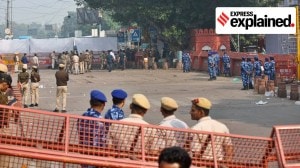The culture that exiles agriculture
Eighty thousand hectares of the finest forest burnt. Only one and a half newspaper notice it. A faltu ka controversy took place on whethe...

Eighty thousand hectares of the finest forest burnt. Only one and a half newspaper notice it. A faltu ka controversy took place on whether we have a real government or a caretaker one. But there was none to take “care” of the burning vitals of India. The national daily originating from Lucknow, very sympathetic to the government, but doing its daily work, reported that the forest mafia and officials worked together and didn’t seem to want to douse the fire and the forest ranger , who seemed idealistic like me, but also young, reportedly cried and said what can he do — no jeep, no phone and no first aid equipment. Since 1980 when the Indian satellites started measuring the actual forest area, it has varied between 63.34 million hectares and 64.2 million hectares. So it can take almost twenty years of effort to grow the forest we lost in this fire, not that we added that much in the period. Even if you put a conservative cost of half a million rupees a hectare, we lost Rs. 4,000 crore. The scam waslarger than Harshad Mehta, but not a single voice was heard from those in authority. Wake up dear reader, before they trade away your and your grand children’s lungs.
Does the problem lie somewhere else? Have we reached a stage that the system does not have the resources to fight an emergency? Agriculture needs public policy and support to help those who would help themselves in taking care of land and water. The Finance Minister gave the usual speech to the CII, but two points he made put paid to any sensible policy for agriculture, if ever taken seriously. He said the revenue deficit would not matter any more and he would, we suppose if he had the way, drop the distinction between plan and non-plan.
One is not quite sure how seriously one can take the threat of ignoring the revenue deficit and giving only the fiscal deficit. After all, this government has been a great spender. It increased the revenue deficit by Rs. 15,000 crore. A few years ago that was the total revenue deficit and not that much before that amount was the revenue surplus. Given these realities the FM’s longing to forget the revenue deficit is understandable, but needless to say unacceptable. No one in his serious mind expects the revenue gap to be closed. Happy with small mercies we will be happy if at least the increase is stopped. This being the case, cutting down the fiscal deficit means that the Finance Minister has unilaterally decided to cut down the plan. Now this is amazing. Here is a government which a few weeks ago announced a five-year plan and got it approved by the nation’s highest policy making body — the National Development Council. The ink was not dry on it when they decided to run it down. On top of it, the FinanceMinister, a member both of the Planning Commission and the NDC, announces a proposal not there in the plan, that he will abolish the distinction between the plan and non-plan. Of course, being a finance minister he does it very carefully, since he has the knowledge that he would not be required to ever defend this in parliament.
The Planning Commission was very modest this time. It said, please cut down the revenue deficit and stop borrowing for wasteful consumption. Once you do that, you can spend on irrigation, agricultural markets and technology. Also, it wanted to spend on the basic common services programme like education, health, drinking water and nutrition. The FM of course would have none of this fine tuning. Earlier after coming back from Washington, Dr Bimal Jalan wanted to abolish the distinction between plan and non-plan but the Planning Commission would have none of it. This time it doesn’t seem to be in the picture anyway. But would someone try and square the circle? Or, non-caretaker governments have the right not to explain the important policy change announcements they make.
These issues are terribly important to agriculture. The government has increased the competitive international economy pressure on India’s agricultural sector through Ramakrishna Hegde’s import policy but if the very modest efforts in the plan to build marketing infrastructure in those regions where such facilities do not exist and to support a policy of infrastructure creation in rural areas are also to be given up, life for Indian agriculture will be impossible.
Meanwhile the international agenda on Indian agriculture is becoming increasingly clear. Last week, the Asian Development Bank had organised, as a part of their annual meetings, a seminar on a study of rural Asia beyond the green revolution. According to ASEAN financial newspapers this was the most popular event in the ADB’s annual meetings, with people sitting on the floor. This newspaper published a report on this meeting coming via Manchester. This report did not give any idea of the discussion which took place on India. I was invited to this meeting from India and it is very clear that the ADB supports a strategic policy framework for Indian agriculture, but enough was said at that meeting to show that for some groups the agenda is to make India to dilute in a significant manner the support it gives to its agriculture. More on this next time, since it is a story by itself.



- 01
- 02
- 03
- 04
- 05




























